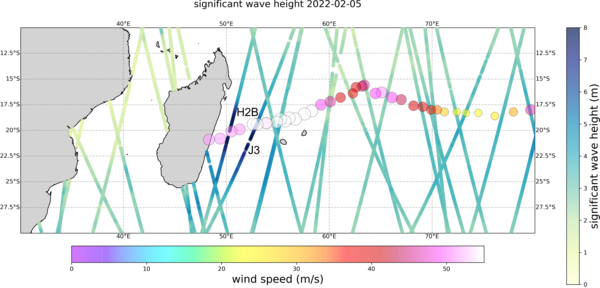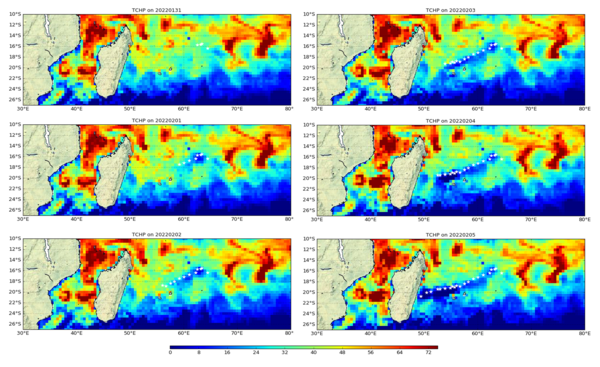Cyclone Batsirai, February 2022
On February 2nd 2022, the cyclone Batsirai intensified to Category 4 on the Saffir-Simpson scale in the Indian Ocean on its way to la Réunion and Madagascar. From 2 to 4 February it reached La Réunion and on 5, it hit Madagascar in Category 3.
Altimetry over Batsirai
The figure below shows the Significant Wave Height measured by seven altimeters flying simultaneously: HaiYang-2B (CNSA/CNES), CFOSAT (CNES/CNSA), Copernicus Sentinel-3A&B (ESA/EUMETSAT), SARAL/AltiKa (ISRO/CNES), Cryosat-2 (ESA) and Jason-3 (CNES/NASA/EUMETSAT/NOAA). Among them, HaiYang-2B and Jason-3 have flown over Batsirai when it was close to Madagascar with values up to 10.8 m and 8.7 m respectively. The products used here are the along-track (level 3) Wave products disseminated by the Copernicus Marine Service (in the product named WAVE_GLO_WAV_L3_NRT_OBSERVATIONS_014_001).
Note that soon with Sentinel-6 Michael Freilich and the future Jason-3 interleaved orbit, the spatial coverage of the altimeters will be improved.

SAR wind speed measurements
Several Synthetic Aperture Radar (SAR) images were acquired with the Copernicus/ESA Sentinel-1A mission during Batsirai's lifetime.
The high-resolution map of the sea surface wind field is derived from the backscatter measurements by combining both the vertical and horizontal polarizations (VV and VH) of the SAR instrument (see plot below using the methodology described in the dedicated paper Mouche et al, 2019).
Thanks to the ESA initiative toward the spaceborne monitoring of Tropical Cyclones, the Satellite Hurricane Observation Campaign (SHOC) consists in a joint effort between the Sentinel-1 mission planning team, IFREMER and CLS. Once an alert is raised, the acquisition plan of both Sentinel-1 A and B missions is modified on short notice to capture the cyclonic event over the oceans before landfall including open ocean and coastal areas. All information on the CYMS website (CYclone MOnitoring Service).
Tropical Cyclone Heat Potential
The ocean heat content called the Tropical Cyclone Heat Potential (TCHP) is the quantity of ocean heat available above the 26°C isotherm (minimum temperature required for cyclone generation). The figure below shows the heat pumped from the ocean by the hurricane in its wake. The TCHP is calculated from temperature data from the global ocean model PSY4V3 developed by Mercator Océan International as part of the European Copernicus Marine Service.
Further information:
- General
- Hurricane Batsirai https://fr.wikipedia.org/wiki/Cyclone_Batsirai
- CYMS (CYclone MOnitoring Service) based on Sentinel-1, an ESA project led by CLS and Ifremer to implement a strategy to monitor Tropical Cyclones using Synthetic Aperture Radar satellites
- Data access:
- Significant Wave Height HaiYang-2B, Copernicus Sentinel-3A&B, CFOSAT, Jason-3 and Saral/AltiKa along-track products form Copernicus Marine Service WAVE_GLO_WAV_L3_NRT_OBSERVATIONS_014_001
- Copernicus Sentinel-1 data from ESA website.
- to compute the ocean energy content, PSY4-V3 model, 1/12° from Mercator Océan from Copernicus Marine Service, product GLOBAL_ANALYSIS_FORECAST_PHY_001_024
- Cyclone positions and winds in https://rammb-data.cira.colostate.edu/tc_realtime/season.asp?storm_season=2022
- Video Observing hurricanes and waves:
- Scientific references:
- Extreme winds with Sentinel-1 :
- Clément Combot, Yves Quilfen, Alexis Mouche, Jérôme Gourrion, Clément de Boyer Montégut, Bertrand Chapron, Jean Tournadre, 2020: Space-based observations of surface signatures in the wake of the 2018 Eastern Pacific tropical cyclones, In: Copernicus Marine Service Ocean State Report, Issue 4, Journal of Operational Oceanography, 13:sup1, s88–s91; DOI: 10.1080/1755876X.2020.1785097
- Mouche Alexis, Chapron Bertrand, Knaff John, Zhao Yuan, Zhang Biao, Combot Clement (2019). Co-polarized and Cross‐Polarized SAR Measurements for High‐Resolution Description of Major Hurricane Wind Structures: Application to Irma Category 5 Hurricane. Journal Of Geophysical Research-oceans, 124(6), 3905-3922. https://doi.org/10.1029/2019JC015056
- A. Mouche, B. Chapron, B. Zhang and R. Husson, Combined Co- and Cross-Polarized SAR Measurements Under Extreme Wind, in IEEE Transactions on Geoscience and Remote Sensing, Vol. PP, Issue 99, pp1-10, 10.1109/TGRS.2017.2732508, 2017
- Extreme winds with Sentinel-1 :






